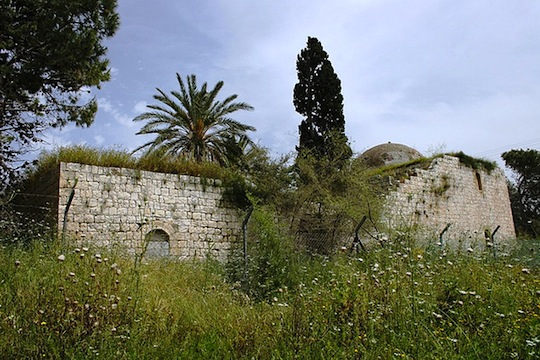A new guidebook provides readers with tours of 18 Palestinian villages depopulated in 1948, allowing Israelis to slowly learn the story of Palestine and create a new reality between the river and the sea.
By Danit Shaham
A book always makes a statement. Whether it’s resting on the table or visible on a shelf, it’s making a statement – cultural, political, or both. Space, on the other hand, represented by maps, hiking trails, signs, is usually viewed as something objective. Neutral. Not subordinated to social, historical or other forms of power.
“Once Upon a Land,” published by Zochrot and Pardes, offers 18 tour routes to depopulated Palestinian villages across Israel, from Zib (Achziv) in the north to Bir Saba’ (Beer Sheva) in the south. The book is written in both Hebrew and Arabic, and is laid out in such a manner that the text flows easily and continuously in either language.
The book is focused, easy to understand, and in addition to the tour routes provides demographic data about the Palestinian villages that were there until 1948 including notes, information about the law, historical background and the current situation, as well as specific directions about how to reach each location.
The guidebook further exposes how space has been designed in a way that silences dozens and hundreds of Palestinian stories, and thereby serves as an additional means to create a Jewish collective consciousness at the expense of Palestinian society. Thus, by providing a resource that in any other context would be viewed as legitimate and non-threatening, it offers readers tour routes which enable them to slowly learn the story of Palestine. Is this a denial of Zionism? Can it co-exist with Zionism? How threatening can this awareness be to Israeli tourists? I wonder.
One would think the question is a personal one, depending on the particular individual. But since that story has been silenced at the national level, I am afraid that the Israeli campaign against the possibility of telling an alternative or parallel story will frighten many people. I already imagine how future hikers will hesitate to page through the book, feeling like traitors if they did.
I expected a standard guidebook that would lead me through familiar sites to tell an unfamiliar story, among trees, along trails and alongside the ruins of a period no one mentions, at least not in Hebrew. I found an amazing educational resource for opening up a reality which, were we able to recognize it, as well as able to recognize Israel’s current reality for what it is, could help us create a new discourse, one that involved more listening and less haggling.
It is hard for me to remain indifferent to descriptions, even when presented neutrally as in any other guidebook. The very act of exposing hidden layers gives rise to simultaneous emotions of understanding, pain and anger. That’s true in the first tour, to discover Zib, which starts at the place that’s known today at the Achziv National Park, where I found myself again aghast as I read the description of the neglected cemetery – especially as someone who makes an effort to visit Jewish cemeteries when travelling abroad, and who expects to find them cared for – to be able to read the names of the deceased on the gravestones and the circumstances of their death, as well as the lovely memorial texts each family chose for its loved one.
It is important to note that the Hebrew proofreading leaves much to be desired with respect to spelling errors, phrasing and excessive detail on some of the routes. These shortcomings, however, are insignificant in comparison with the content provided. It is a breath of fresh air: interesting, challenging and serves as an additional way of reexamining our reality. As Rachel Leah Jones writes in the tour of Ayn Hawd, Ein Hod and Ayn Hawd al-Jadida: “We’ll put on bifocals that will show us all of history’s contradictory layers. We don’t want to see only what used to exist and make believe it’s possible to ignore the present. Bifocal vision means seeing Israel/Palestine simultaneously: just like Israel/Palestine, what appears to be beautiful is very beautiful – and also extremely ugly; very sweet and also terribly bitter. There are many ways of approaching this reality, and this is only one of them.”
History, as we know, is written by the victors. It is never an objective account. That’s why the task Zochrot undertook – to create a guidebook that will bring to life Palestinian history in the pages of the book as well as by allowing people to walk along its tour routes – is more than a fantastic story: it is an important milestone. The book is an honest effort that enables me to hear another account of what used to be here until 1948, and still exists today in the hearts of millions in the Middle East and throughout the world.
Danit Shaham is the Human Rights Education Director at Amnesty International Israel.

